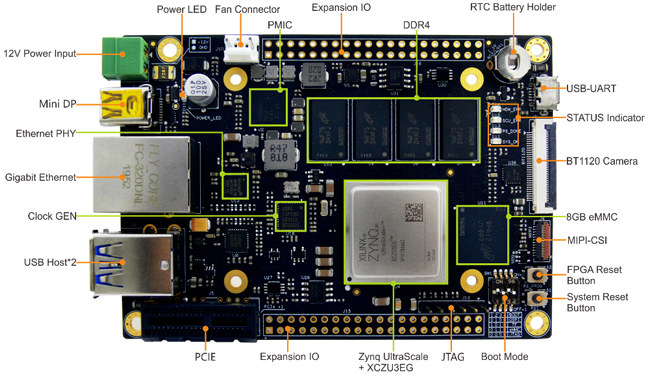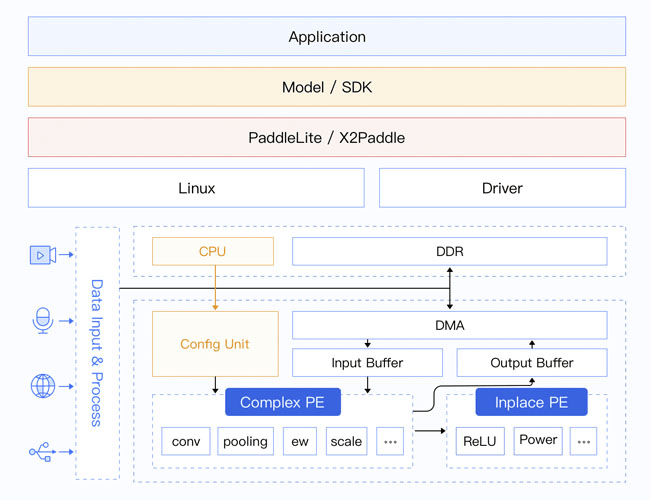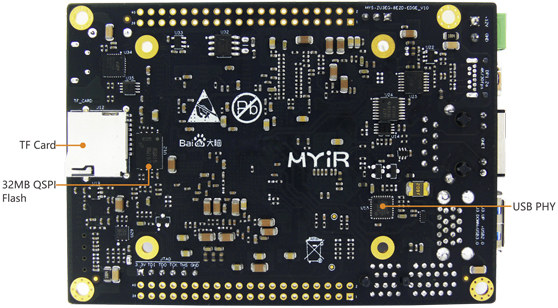MYIR’s FZ3 card is a deep learning accelerator board powered by Xilinx Zynq UltraScale+ ZU3EG Arm FPGA MPSoC delivering up to 1.2TOPS for artificial intelligence products based on Baidu Brain AI open platform.
The FZ3 card also features 4GB RAM, 8GB eMMC flash, USB 2.0 & USB 3.0 ports, Gigabit Ethernet, DisplayPort (DP) output, PCIe interface, MIPI-CSI and more.
MYIR FZ3 card specifications:
- SoC – Xilinx Zynq UltraScale+ XCZU3EG-1SFVC784E (ZU3EG) MPSoC
- Quad-core Arm Cortex-A53 @ 1.2 GHz
- Dual-core Arm Cortex-R5 processor @ 600MHz
- Arm Mali-400MP2 GPU
- FPGA fabric
- System Memory – 4GB DDR4
- Storage – 8GB eMMC flash, 32MB QSPI flash, 32KB EEPROM, MicroSD card slot
- Video Output – 1x Mini DisplayPort up to 4Kp30
- Camera I/F
- 1 x MIPI-CSI Interface (25-pin 0.3mm pitch FPC connector)
- 1 x BT1120 Camera Interface (32-pin 0.5mm pitch FPC connector)
- Connectivity – 1x Gigabit Ethernet
- USB – 1x USB 2.0 Host, 1x USB 3.0 Host
- Expansion
- 1x PCIe 2.1 Interface (1-lane)
- Two 2.54mm pitch 2×20-pin IO Expansion Interfaces with up to 1x CAN, 1x RS485, 2x USB Host 2.0, 12x pairs HD_IO, 8x pairs HP_IO, 4x PS_MIO
- Debugging – 1x Mini USB-to-UART Port, 6-pin JTAG header
- Misc – Power LED, 4x status LEDs (2x red, 2x green), FPGA Reset button, System Reset button, RTC battery socket (AG2 or LR41 battery recommended), heatsink and fan
- Power Supply – 12V/2A
- Dimensions – 100 x 70mm (12-layer PCB)
- Temperature Range – -40°C~85°C
The board looks more like a single board computer (SBC) than what I would typically refer to as a “card” since it’s a Linux SBC with integrated Arm cores and FPGA fabric.
FZ3 card runs PetaLinux, and supports Baidu PaddlePaddle deep learning AI framework, as well as Baidu Brain AI tools such as EasyDL, AI Studio, and EasyEdge. Those enable the development of deep learning applications such as smart cameras, AI Edge embedded PCs, AI robots, smart cars, intelligent electronic scale, autonomous UAV, and more.

I had never heard about Baidu’s PaddlePaddle (PArallel Distributed Deep LEarning) machine learning framework, but I should probably have since it was released in 2016, and the company says Baidu Brain has been offering over 228 AI capabilities to over 1.5 million developers.
Baidu recently released Paddle Lite 2.0 tailored for inference on mobile, embedded, and IoT devices, compatible with PaddlePaddle and pre-trained models from other sources, and support for edge-based FPGA units.
MYIR FZ3 card is sold for $259 as part of a kit with a 12V/2A power adapter, a 16GB MicroSD card, a mini USB cable, a Mini DP to HDMI cable, and a product disk. It will also be sold standalone, but no price has been indicated.
That’s quite a steep price for a system delivering only 1.2 TOPS considering Orange Pi 4B SBC with Rockchip RK3399 SoC and a Gyrfalcon Lightspeeur SPR2801S NPU delivering up to 2.8 TOPS can be purchased for $70. IMHO, the board is mainly interesting for people specifically wanting to test and evaluate Baidu PaddlePaddle and Brain AI tools on an edge, or alternatively for developers wanting a relatively affordable Zynq UltraScale+ ZU3EG board.
More details and purchase link can be found on the product page.

Jean-Luc started CNX Software in 2010 as a part-time endeavor, before quitting his job as a software engineering manager, and starting to write daily news, and reviews full time later in 2011.
Support CNX Software! Donate via cryptocurrencies, become a Patron on Patreon, or purchase goods on Amazon or Aliexpress





